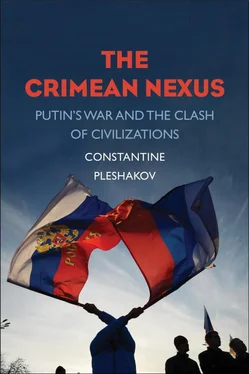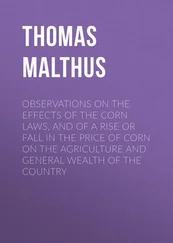Ostensibly to protect the ethnic Russian population in Crimea and potentially elsewhere, Putin asked the Russian parliament to authorize the use of troops in Ukraine. On March 1, the parliament obliged. By then, in reality, the stealth invasion was well under way, and the “little green men” were already on the ground in Crimea.
Russia’s annexation of Crimea was a reactive act, a hard-power response to American involvement in the Kiev crisis, which had culminated in a regime change. It is difficult to dispute that Russia had legitimate strategic interests on the Crimean Peninsula. Sevastopol was the Russian Black Sea Fleet’s only major base, and the revolutionary Euromaidan had made the Kremlin believe it might be slipping away. No American leader had seriously considered adding Ukraine to NATO, but several who were no longer in a position to make anything of the kind happen, including former secretary of state Hillary Clinton, pretended that it had to be done. The noise such statements made hid their hollowness from the Russian ear. By striking in Crimea, Moscow believed it was preemptively getting control over the peninsula before NATO arrived.
Not some piecemeal or creeping expansion, but a brazen gambit, the annexation announced to the world that Russia had “risen from her knees” (in Putin’s words), that the country was strong and determined to defend its spheres of influence, by military force, if necessary. After years of warning the West that interfering in Ukraine would be crossing the red line, the Kremlin felt it could not but respond.
No other aggression could be sold to the Russian public so easily. Most Russians could be expected to support the action because Crimea was a national fetish that had ended up in Ukraine accidentally, due to a bit of political pandering by Nikita Khrushchev in 1954.
The term “revolutions of Crimea,” meaning cycles of violent transfer of power from one dominant group to another, comes from eighteenth- and nineteenth-century European visitors. They used the term “revolution” as in “revolving door,” not as in “overthrow of a government in favor of a new order.” Such cycles seem to be the structural framework of Crimea’s history.
Crimea is a natural lure; a fat piece of low-hanging fruit dangling from the continent’s underbelly, strikingly warmer and lusher than the adjoining northern plains. The eighteenth-century British traveler Elizabeth Craven compared its steppes to “the finest green velvet”; the Tatar nickname for Crimea is Yesil Ada, or Green Isle. [1] Elizabeth Craven, A Journey Through the Crimea to Constantinople (London: Robinson, 1789), 162; Brian G. Williams, The Crimean Tatars: The Diaspora Experience and the Forging of a Nation (Leiden: Brill, 2001), 88.
It sits on a busy intersection. In the past, peoples that had never heard of it—early nomadic groups like the Huns, Goths, and Kipchaks—still found themselves at its doors while traversing the east-to-west corridor across Eurasia.
Crimea is also a trap. It is very close to being an island, and like an island, it is difficult to evacuate in case of a foreign invasion. The Perekop Isthmus, just four miles wide, is too narrow to let one dodge an invading army, and the Kerch Strait, two miles across, is uncomfortably wide to traverse by boat. As hard as it is to leave physically, it is almost as hard to let go emotionally. Every group exiled or pushed out from Crimea has mourned the loss of Eden ever since, perpetuating the separation trauma for future generations. There has never been a unique Crimean product or resource that would be a hot commodity on world markets, except for the peninsula itself, a fetish in many cultures, epitomizing comfortable living in an accommodating environment.
For the people of the north—first nomads, then Slavs—Crimea was the most verdant place they had ever seen. For the people of the Mediterranean—Greeks, Jews, Italians—it was the northernmost breath of familiar terrain. Significantly colder than Attica, Liguria, or Palestine, it was nevertheless recognizable, acceptable, homelike.
For a place the size of Massachusetts—ten thousand square miles—Crimea is extraordinarily diverse: steppes, salt marshes, a desert, three mountain ranges, five plateaus, a subtropical littoral. Until the mid–twentieth century, its population was comparably diverse: Tatar, Turk, Russian, Ukrainian, German, Karaite, Jewish, Armenian, Bulgarian, Italian, Greek. With only a certain degree of exaggeration, a medieval visitor from Europe reported that nearly every settlement along the South Shore had its own language. [2] The Journey of William of Rubruck to the Eastern Parts of the World, 1253–55 (London: The Hakluyt Society, 1900), 51.
Crimea’s history is of successive waves of colonization: early nomads; Greeks and Romans; Byzantines; Genoese and Venetians; Tatars and Ottoman Turks; Russians and Ukrainians. Alongside the dominant groups came minorities. Never noticeable politically, Armenians, Jews, Germans, and others were yeast to the peninsula’s economy. Maintaining close ties with their kin overseas, they had shaped Crimea’s cosmopolitan character and made it a hub of maritime trade. Though locked together in a small space, these ethnicities and their economies did not merge. Crimea developed not as a melting pot but as a salad bowl. Each of its urban neighborhoods had a distinct ethnic character, as did the villages in the countryside.
On a macro level, Crimea falls into three distinct zones: the steppes, the mountains, and the littoral. “Its northeastern division is a steppe and has neither tree nor hill, but its southern part presents a far different appearance, the mountains rising to a considerable height and encircling valleys of great beauty and fertility,” an early U.S. Navy manual says. To an American eye, the gently rolling Crimean steppes resemble the Great Plains—and the South Shore, the Pacific coast. [3] The Black Sea Pilot (Washington: Hydrographic Office, U.S. Navy, 1920), 205; Edward R. Stettinius, Roosevelt and the Russians: The Yalta Conference (Garden City, New York: Doubleday, 1949), 81.
In the days of horseback travel, the steppe took five days to cross north to south. Traditionally, it belonged to nomads—Taurii, Cimmerians, Scythians, Sarmatians, Goths, Huns, Kipchaks. The historian Brian G. Williams writes: “From the dawn of recorded history, the plains of the northern Black Sea were dominated by nomads who mounted hardy steppe ponies, mastered the deadly art of mounted archery and fought one another for control over the rich pasture lands.” The weapons and strategy applied in this endless struggle remained basic yet effective. According to estimates by Edward N. Luttwak, a nomadic expeditionary force could cover between thirty and fifty miles per day “for quite a few days in a row.” The army of the strongest sedentary state in the region, Byzantium, could not exceed fifteen. [4] The Journey of William of Rubruck , 51; Williams, The Crimean Tatars , 15–16; Edward N. Luttwak, The Grand Strategy of the Byzantine Empire (Cambridge, Mass.: The Belknap Press, 2009), 32.
According to Brian G. Williams’s history of the region, the “losers in these largely unrecorded struggles” for control of the steppes “were either absorbed by the victors or scattered into mountain ranges of the south”: the Crimean mountains served as “a sanctuary for tribes and ethnic groups fleeing the waves of more powerful nomadic groups.” One group, the Goths, maintained a steady presence in the mountains for centuries. The commercial nations of the Mediterranean occupied the littoral. [5] Williams, The Crimean Tatars , 14–16; Maria Guthrie, A Tour, Performed in the Years 1795–96, Through the Taurida, or Crimea (London: Cadell and Davies, 1802), 52.
Читать дальше












